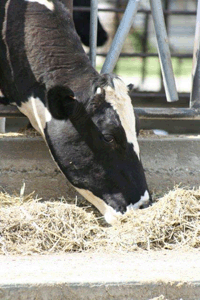There is no time to waste when butterfat levels drop.
Depending upon how you're paid for your milk butterfat can add a significant amount to your milk check. Looking back to 2011, butterfat averaged $2.15 per hundredweight, and that's no small change. When milk fat levels are depressed, there is no time to waste in finding the cause and resolving the issue quickly.
Hot weather is often blamed for suppressing fat levels, but milk fat depression is actually a multifactorial problem with many moving parts, says Martha Baker, dairy nutrition specialist with Purina Animal Nutrition LLC.
Whether you're struggling with milk fat depression or want to head it off at the pass, here is a look at six key areas that can influence milk fat production.
Management
Take a look at your total mixed ration (TMR). Evaluate delivery times - including nighttime feedings, feed refusals, availability of bunk space and overcrowding. Avoid slug feeding, as it can create subclinical acidosis which impacts milk fat. "Any of these issues should be addressed right away," says Baker.
Forages and fiber in the diet
Concurrently, while you are taking a closer look at management factors that influence milk fat, examine the forage and fiber levels in the diet. Use the Penn State Shaker Box to evaluate particle length. "The goal should be to have 47 percent of the TMR in the bottom and 7 percent on top," says Baker.
Cud chewing can also be a good indicator of forage and fiber in the diet. "Look for 50 percent or better of the pen to be chewing their cud," she says. The percent of neutral detergent fiber digestibility (NDFD) should also be evaluated to make sure it isn't too high.
Starch content
Assess how many pounds and what percent starch is being fed. Technology like rumen degradable starch testing can help assess starch levels in the ration ingredients and how they will perform in the cow. "Different ingredients ferment faster in the rumen than others. This affects the dynamics of the rumen and can have a major impact on milk fat levels," explains Baker.
"An awareness of the rate of starch digestion, especially in the rumen, is critical when trouble shooting milk fat depression," she says. "Rumen degradable starch testing allows you to very quickly rule out starch as a culprit of suppressed milk fat levels."
Fats saturated vs. rumen inert
Consider the fat level and source in the diet. There shouldn't be more than 5 percent fat in the diet, notes Baker. Be mindful of polyunsaturated fatty acid or PUFA levels.

Once care has been taken to maintain proper total fat levels, evaluate the source. The different compositions of fat fed impact milk fat. "Our continued use of highly unsaturated byproducts to other animals has the ability to impact the saturation level of the tallow. As a result, the level of saturation of the fat sources at the mill you work with may have changed unbeknownst to you," notes Baker
Yeasts and molds
Consider the level of yeast and mold that might be in the diet. Lower the amount of feed coming from the affected source; dilute it with other non-affected feedstuffs. Research is ongoing surrounding the negative impact yeast and molds have on milk fat depression.
Feed additives
Take into account feed additives that could help improve milk fat levels.
"There are many pieces that make up the milk fat depression puzzle, and therefore it's important to be aware of all the components," says Baker. "Awareness of all these parts and addressing them to some degree simultaneously will allow you to rapidly fix the problem." She explains that if you address one issue at a time it may take too long to find the cause of the milk fat depression, and as a result the herd will lose money.
"Remember, when formulating rations, it should always be top of mind to feed every cow, exactly what she needs, where she needs it, when she needs it nothing more and nothing less," says Baker. This approach will aid dairy farmers in capturing opportunities for improved efficiency and bottom line potential.
For more information, contact your local Purina Animal Nutrition representative or go to: www.lolfeed.com.
Purina Animal Nutrition LLC, in connection with its wholly owned subsidiary Purina Mills LLC, is North America's leading feed company serving producers nationwide through local cooperatives and independent dealerships by providing an extensive line of animal nutrition, ingredients and expertise.
08.15.2012